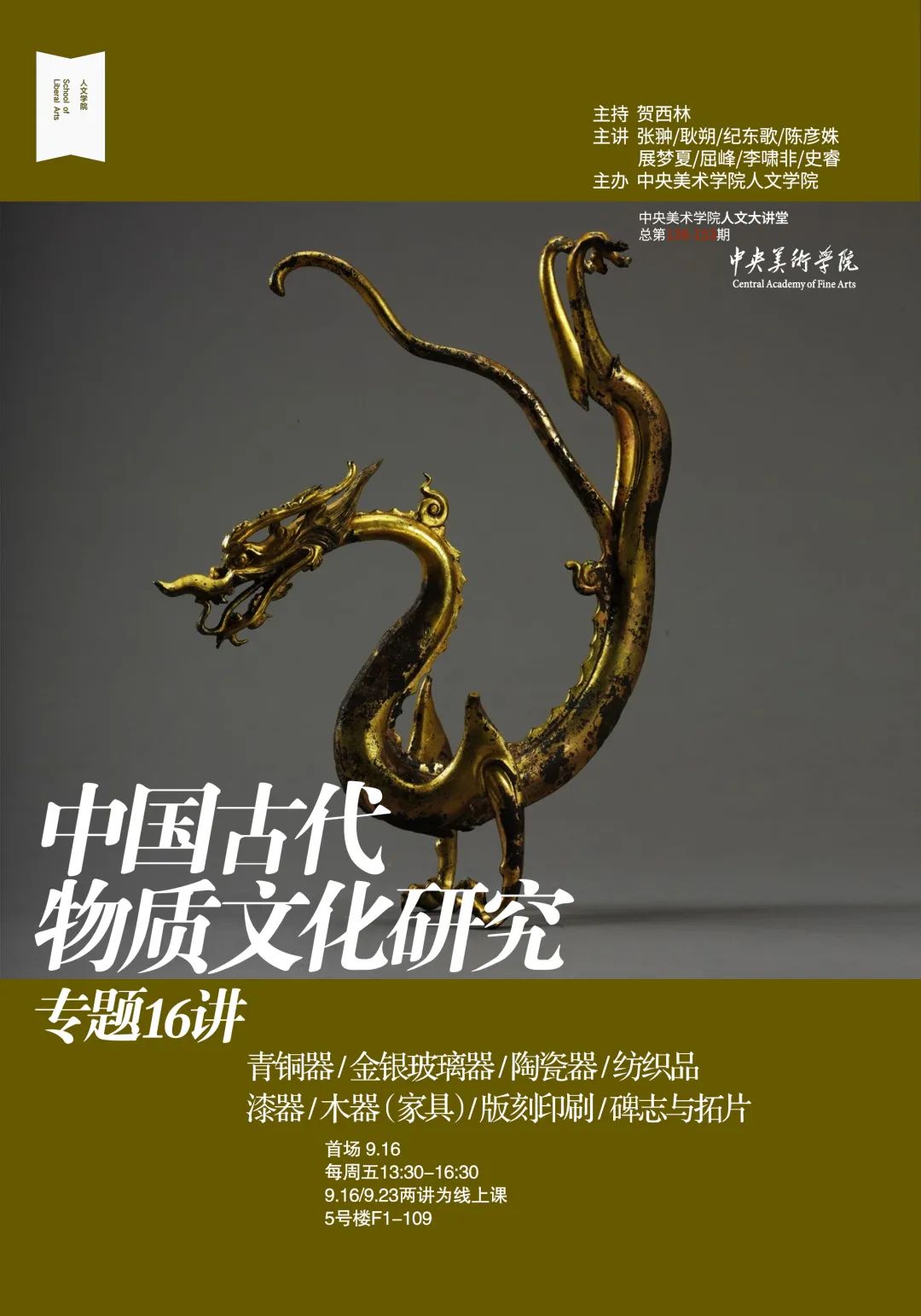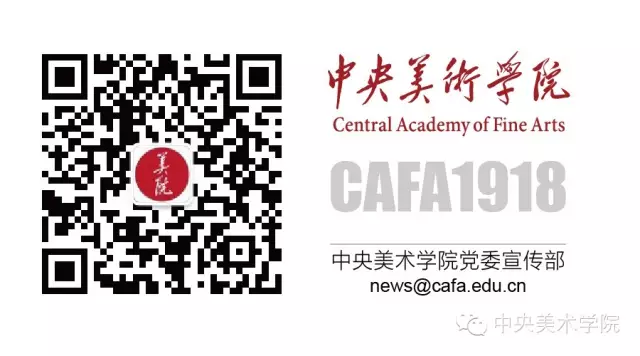Lecture 丨 Ancient Chinese Material Culture Research Topics Sixteen Lectures
Author:Central Academy of Fine Arts Time:2022.09.16
Source: Central Academy of Fine Arts School of Humanities
Central Academy of Fine Arts
Humanities Lecture Hall President No. 138-153
16 Lectures on the Topics of Ancient Chinese Material Culture Research

Sixteen Lectures on the Topics of Ancient Chinese Material Culture Research
Moderator: He Xilin
(Professor of the School of Humanities, Central Academy of Fine Arts)
Time: 13: 30-16: 30 every Friday, the first lecture time is September 16th
Location: F1-109 classroom (two lectures on September 16 and 23 for online classes)
one
Bronze
Speaker: Zhang Yan
(Associate Researcher of the Institute of Ancient History of the Chinese Academy of Social Sciences)
Lecture first: Bronze shape and decoration and casting technology
Summary of content: This lecture uses the relatively familiar concepts and specific decorations of art history, leading everyone to have a common understanding of Shang and Zhou Bronze. Through special research on the noodles and double -body decorations, this lecture will be expanded with three sections or three small problems. Considering the image research of the decoration, it also involves the production problems of copper components and blocks, so as to comprehensively consider the relationship between the shape, structure, and decoration, and extend through the shape and decoration to the understanding of the bronze casting technology. For example, combined, dividing, and losing wax, if there is any power, it can also involve the methodology of copper research.
Lecture 2: The relationship between the name of the bronze ware
Summary of content: On the basis of the demeanor of the bronze ware, the extension of the name and device class of the bronze ware. This lecture has been carried out through the academic case of the wares, discussed the principle of names, involving the scene of the use scene, the ceremonial understanding of later generations, and the vision of modern academics. Through the study of the type of copper, you can lead everyone to understand the combination of utensils and device categories, and discuss the correlation between the style of the font of the golden text and the utensils as appropriate. Finally, through the utensils of Wei Bean to discuss women's uses after the late Western Zhou Dynasty, this will involve issues such as gender history, cultural history, and social history such as ethnic nationals, nuns, and regional exchanges.
two
Gold and silver glass
Lector: Geng Shuo
(Associate Professor of the School of Humanities, Central Academy of Fine Arts)
Third Lecture: Inheritance and Exchange -Ancient Chinese Gold and Silverware
Summary of content: This lecture will introduce the basic concepts and main characteristics of gold and silver wares, sort out the academic history of the study of ancient Chinese gold and silver instruments, and the lectures are analyzed in various periods in the order of general time, mainly because of the important archeological discoveries of gold and silverware during the medium and ancient times, , Discuss the shape, decoration, production, use of various representative utensils, and various impacts on Chinese society, especially in the background of the Chinese and foreign cultural exchanges brought about by the Silk Road to examine the rich connotation contained in gold and silver wares.
Lecture 4: Glassware and ancient Chinese society life
Summary of content: This lecture is described to introduce the definition and origin of the glassware, analyzes the various titles of "glass" in ancient Chinese books, shows the physical overview of ancient glassware found in China, analyzes its era, regional and class characteristics , Discuss their shape decoration, production process and functional purposes, examine the exchanges of ancient Chinese and foreign technology and cultural levels reflected by glassware, and combine related images and literary materials to explore the role and status of glass in the process of Chinese social life in China. , Show the significance of multidisciplinary research in the field of ancient glassware.
three
Ceramic
Speaker: Ji Dongge
(Deputy Research Librarian of the Ministry of Culture and Technology of the Palace Museum)
Lecture 5: Technology and communication of ancient Chinese ceramics
Summary: This lecture mainly involves four items, that is, what is ceramic, an overview of Chinese ceramic production technology, Chinese and foreign exchanges behind technological innovation, as well as the interaction between technology, life and culture. As the earliest artificial product of human transformation of natural physical transformation of nature, ceramic articles penetrate in all aspects of the process of civilization. Ceramic manufacturing technology has always been the core and foundation of its development. China's advanced cultivation technology is widely popularized and disseminated by ceramics. Basic conditions. The development of several major ceramic varieties such as Chinese celadon, white porcelain, and color porcelain, the formation and growth of the famous kiln systems of previous ages have been driven by several technological innovations. All of these innovations and changes are behind technical exchanges and personnel flow. Completed. Since the Tang Dynasty, Chinese ceramics have been discovered around the world. The spread of porcelain technology, the formation of "ceramic culture" and the needs of diversified demand have become the main factor affecting production. Based on literature, archeological discovery, and scientific analysis data, this lecture discusses the main reasons for promoting ancient ceramics production and development, and discusses the connection between technology, material life and cultural communication with ceramics as the carrier.
Lecture 6: Practical and aesthetics of ancient ceramics
Summary of content: As a research object of material culture, ancient ceramics plays an important role in understanding the history of hand industry, cultural history, and socioeconomic and economic history. This lecture is based on the birth and development of Chinese ceramics, and discusses the cause of ceramic from the Neolithic period to different stages of the Qing Dynasty. Different regions are designed, produced, used, and collected by different people. By analyzing the three stages of ceramic appearance: from the birth of pottery to porcelain (the Neolithic to Shangwei), the ritual and antique (Song), the imperial kiln porcelain (Ming and Qing), discuss the actual functions and functions of ancient ceramics and Behind the continuous transformation of aesthetics, the economic level, social structure, and cultural fashion changes, and the interaction and influence between functions, culture and aesthetics.
Four
textile
Speaker: Chen Yanyi
(Associate Professor of the Academy of Fine Arts of Tsinghua University)
Lecture seventh: production · consumption and appreciation -the three perspectives of understanding the textiles: Textiles are related to the country and people's livelihood in ancient China. This lecture tries to sort out the characteristics of textiles from a macro perspective, to show the characteristics of textiles, and show the interaction of economic history, handicraft history and art history. Production, describing its status nature, category and craftsmanship, historical production areas, regional naming, organizational and management of government production. Consumption, depending on level and prohibition, typical time, clarify the change of artistic style. Appreciation, focusing on how weaving and embroidery enters the field of collections, and are appreciated and written as artworks. The purpose of this lecture is to establish a historical framework, not all of them, and several issues will be used to show research ideas and methods.
Lecture eighth: Silk on the Silk Road -Witness of Chinese and Foreign Cultural Exchange
Introduction: The topic of this lecture is concentrated in the Han Dynasty, the Song and Yuan Dynasties, and started with the introduction and spread of artistic style, craft technology, and typical varieties. From the perspective of material culture, how to use archeological and art history materials to explore the cultural phenomenon behind the works. The Eastern Han-Wei Jin, looking at the process of silk, the process of reducing the Han Yun and the gradual style of the new style, correctly understand the "front and back style changes" of the Han Dynasty silk. In the late Northern Dynasties-Sui, Hu Feng gradually started, seeing cultural understanding and transformation through the patterns of the early beads fabrics. The Northern Dynasties-Yuan, Isaac answering the clue of Zandaniji in China to see the continuous relationship. Mongolian Yuan, the combination of Mongolia, Islam, and Han culture, the new trend of decorative art.
five
lacquerware
Speaking: Zhan Mengxia
(Deputy Research Librarian of the Department of Overstrors of the Palace Museum)
Lecture ninth: history of lacquer, lacquerware and lacquerware
Summary: The main content of this is to introduce some basic concepts related to the lacquerware. First, clearly refer to the specific context of the study of ancient Chinese lacquerware research, and briefly introduce the basic process of cut lacquer and paint on this basis. Second, propose a new way to define the "lacquerware", and summarize the tire making and decorative process of lacquer wares and the variety of lacquerware. Third, a brief review and comment on the status quo of the ancient lacquerware research.
Lecture Tenth: For the use of lacquer -the history of ancient Chinese lacquerware
Summary of content: The main content of this is based on the different roles played by lacquer wares in social life in different historical periods, and the history of ancient Chinese lacquerware is connected in series. Generally, the history of lacquerware and lacquer art is written in the order of dynasties. This lecture is divided into four stages according to the different social roles of lacquer wares, rituals, practical devices, and appreciation products. Systems, craftsmanship, decorative patterns, etc., try to reveal the overall laws and fundamental motivation of lacquerware development.
six
Wood (furniture)
Speaker: Qu Feng
(Research librarian of the Ministry of Culture and Technology of the Palace Museum)
Lecture 11: Look at the development of furniture from the structural method
Summary of content: When humans start to pay attention to the comfort of sitting and lying in life, when the behavior of the original in the plane space is expanded to the three -dimensional space, the furniture is arisen. And with the continuous increase of human attention, the types of furniture generated by the corresponding furniture are becoming richer. This can be regarded as a direct cause of furniture. However, the cause of the movement is only an internal driving force to achieve the existence of furniture and material form, but the corresponding technical means need to act on material materials. This lecture will be observed from the basic technical method of furniture formation -structural methods, the structure method of the development of furniture, showing and analyzing the changes in the development of furniture and these changes and production technology, people's behavior, life concepts, aesthetics, aesthetics, aesthetics, aesthetics Fun relationship.
Lecture 12: History of furniture writing in chair
Summary: Chairs are the most common and most diverse types of furniture in furniture. Where does the chair come from? How does it step out of its own development history? At different historical stages, what changes have the chair? This lecture condenses its eyes on the chairs of different periods, observe their shape style, structure, material characteristics, manufacturing process, etc., and combine the specific historical and cultural background to explore the reasons for these changes. Pay attention to the entire history of furniture.
seven
Version printing
Lector: Li Xiaofei
(Associate Professor of China Arts and Crafts Museum of Art in China)
Lecture 13: The ancient Chinese version of the media and technology
Summary: Edition, generally refers to the traditional wood version of carving. As a part of material culture, the media and technology involved in the version profoundly affects its way of responding to different contexts. The main purpose of this lecture is to examine the diversification of the version carved in ancient social life. The plan is based on the development and evolution as the background, and enters the discussion of two themes: first, the version of the version of the media selection and its source; the second, the technical support and technological innovation of the engraving. Combined with the performance of the version and cultural context, explore the "operating logic" behind it.
Lecture 14: Reading and reading pictures- "History of printmaking"
Summary of content: This course focuses on the title of "printmaking", analyzes the relevant concepts, and starts the discussion of the objects, methods and scope of the research on "printmaking history". The prints are no longer regarded as an isolated graphic picture, but the "composite thing" made of society and groups, history and concepts. Through the analysis of related cases, the themes of printmaking and books, versions, utensils, architecture and other themes, as well as the significance of cross -cultural and interdisciplinary research in the fields of printing history, technical history, publishing history, social history. Eight
Monument and Top Film
Lector: Shi Rui
(Associate Research Librarian of the Ancient History Research Center of Peking University)
Lecture 15: The materiality and text of the monument
Summary: Monument research is a comprehensive research work that requires many fields such as cross -stone carving, archeology, literature, and history. This lecture discovered the association of monuments and epitaphs from the three links of production, circulation, and interpretation, and explained the origin of the tomb stone carvings. Compare the characteristics, form and content of the inscriptions and epitaphs. Analyze the relationship between the presentation strategies and results of the stone carving carving and the cultural personality and cultural level of the text, the process and changes of the monument production, the decision maker, the monument owner and the family member, the writer, the writer, the writer, the writer, the writer, the writer, The rich connection formed by the engraved, the viewer, the viewer, and the written passage. The monument itself and the literature records can form a relationship between each other, and there are the same thing as other categories unearthed. In short, the study of monuments from the history of material culture will expand our vision and cognition and bring more results.
Lecture 16: Cultural History Examination of Monument and Top Films
Summary of content: As a cultural historical phenomenon, the inscriptions are very rich in the connotation of the concrete culture and abstract culture. This lecture explores the deep connotation of monument culture from the perspective of calligraphy culture, political culture, religious culture, and folk culture. The writing, replication, and the transmission of the inscriptions involved in the inscriptions, the relationship between the identity of the book and the circulation of the work, the political meaning and cultural significance of the inscription in the building landscape. Landmarks, the promotion itself constitutes an important historical element, the beliefs and folk concepts of the monument, and also have an important place in cultural history. The extension that is out of the monument also has the dual meaning of cultural relics and literature. Urgently need to be excavated. It is hoped that the cultural history inspection of the monument will promote the linkage of the research and general historical research.
Editor -in -law 丨 Wu Qiong
Edit 丨 He Yifan

- END -
[2022 China has an appointment] "Green Barrier" on the edge of Tengger Desert

On June 27, the interview group of 2022 China had an appointment with A Date with ...
[Entrusted new journey to build a new era, the new era · extraordinary ten years] Hansing District strives to culture "two innovations"

Hansing District strives to two innovations,Promote traditional culture and new ne...